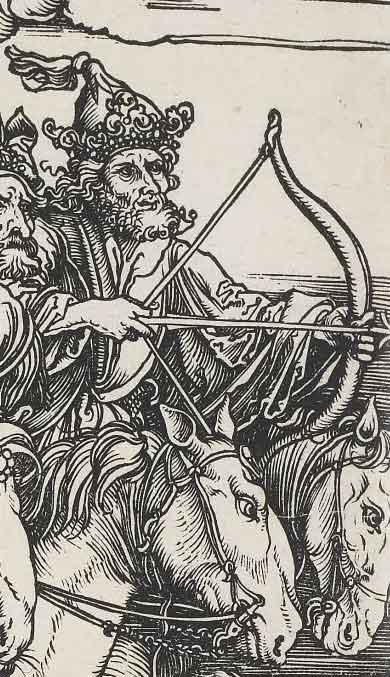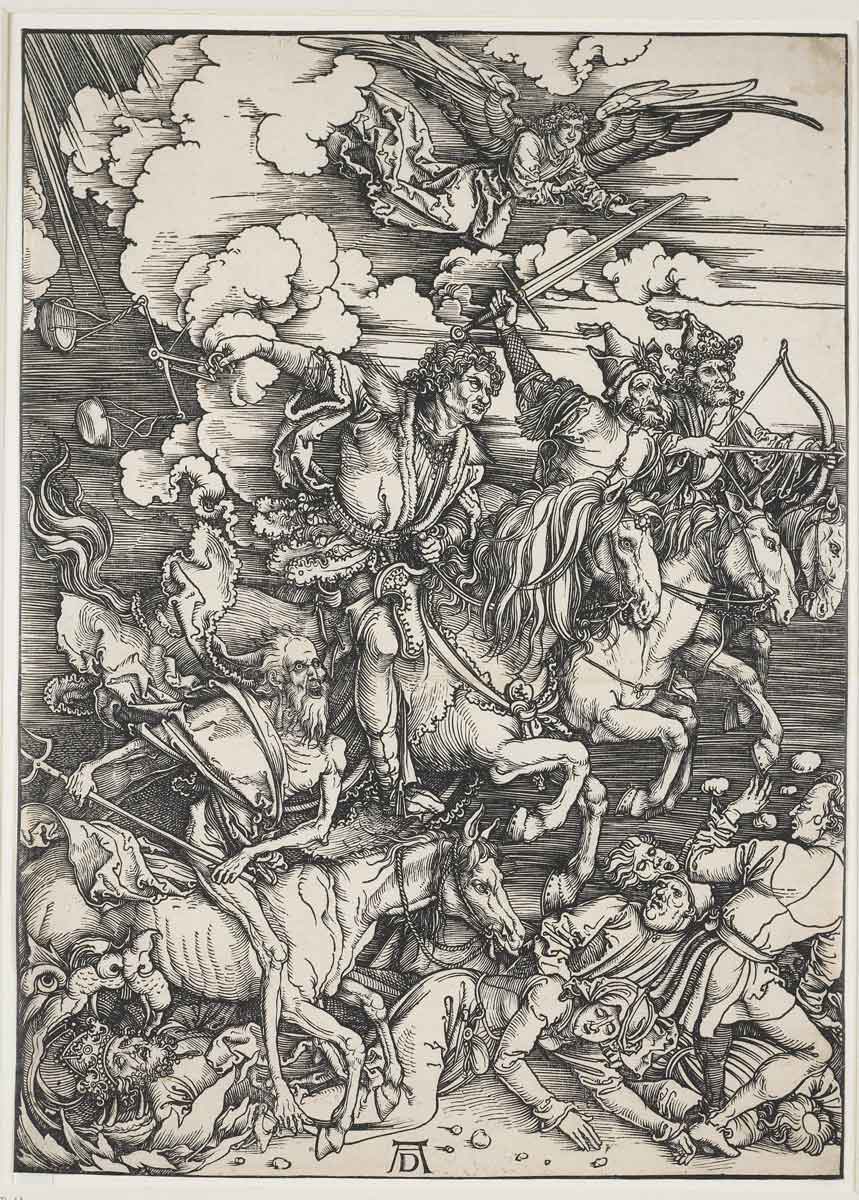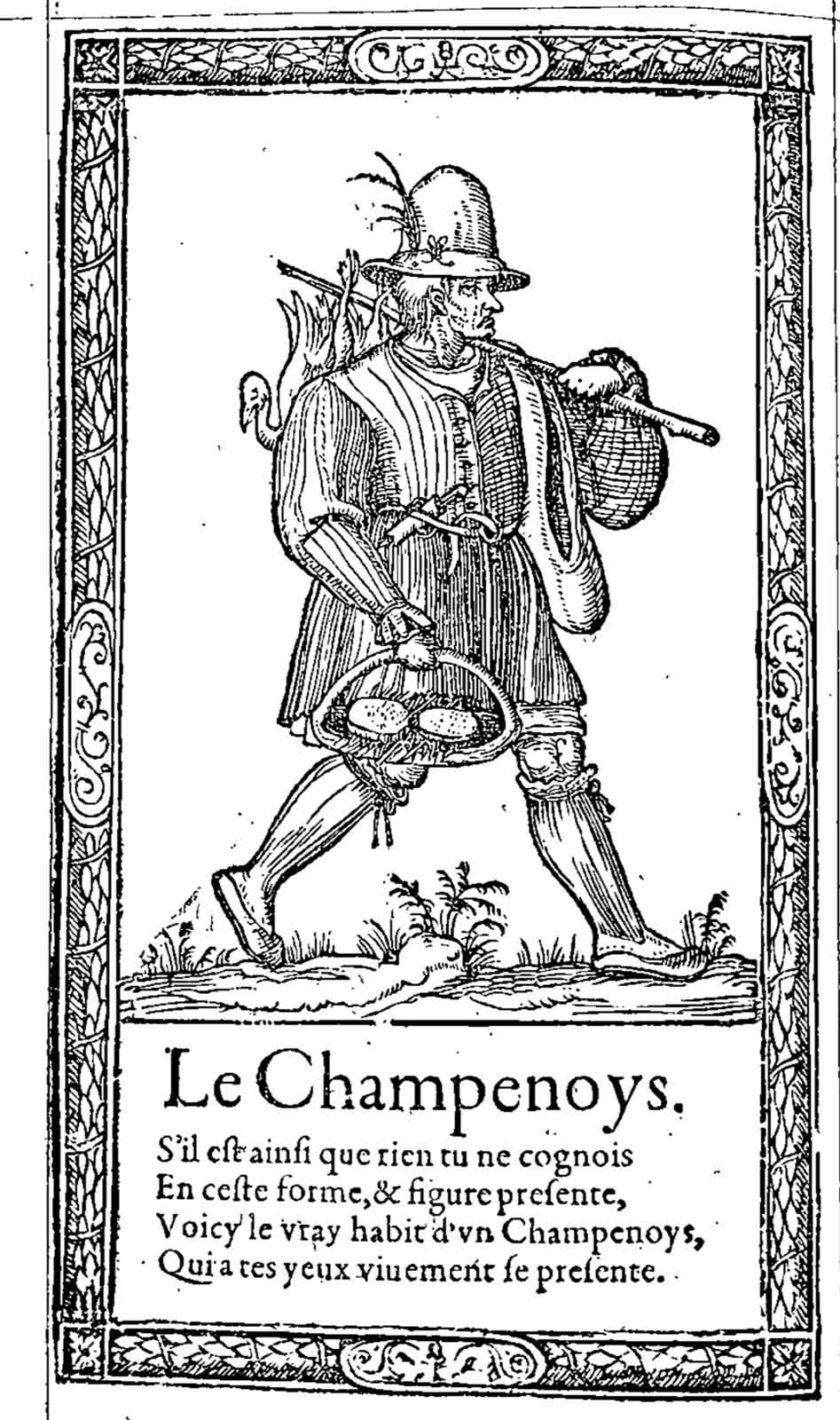And as if were a sacred herb,
Original French: Et comme ſi feuſt herbe ſacre,
Modern French: Et comme si feust herbe sacre,
Original French: Et comme ſi feuſt herbe ſacre,
Modern French: Et comme si feust herbe sacre,
A sling, to cast stones with.
Frondes. Cf. Prol., n. 70.
Did this occur during Brutus’ campaign in Spain?
Original French: les arbeleſtes bandées,
Modern French: les arbelestes bandées,
A Crosse-bow; also, a Bow-net; also, the sinewie Cross-bow, wherewith a man shoots, not deere, but his deerest.
Original French: Par elle ſont les arcs tendus,
Modern French: Par elle sont les arcs tendus,

Detail of the four horsemen of the Apocalypse; four horsemen representing death, famine, war and conquest, ride from left to right over various people, in the lower left corner Hell devours a ruler wearing a bishop’s mitre combined with an emperor’s crown. One impression without text from a series of 15 woodcuts. c.1497-8.

The four horsemen of the Apocalypse; four horsemen representing death, famine, war and conquest, ride from left to right over various people, in the lower left corner Hell devours a ruler wearing a bishop’s mitre combined with an emperor’s crown. One impression without text from a series of 15 woodcuts. c.1497-8.
Original French: Par elle ſont bottes, botines, botaſſes, houzeaulx, brodequins, ſouliers, eſcarpins, pantofles, ſauattes miſes en forme & vsaige.
Modern French: Par elle son bottes, botines, botasses, houzeaulx, brodequins, souliers, escarpins, pantofles, savattes mises en forme & usaige.
A buskin, or Summer boot.
bedaine :
Vostre corroye et botasse lairay
Cheoir du tout, ne faites que soufler
Et en allant comme ub pourceaulx ronfler
Ventre puans.
(E. Desch., Poés., Richel 849 f° 186.)
A course drawer worne over a Stocking in stead of a Boot.
Il a laissé les houseaux. He hath got him to (his last) bed; he as even as good as gone; he is no better than a dead man.
se Houser. To pull on drawers; to draw on bootes.
À l’an soixante & douze, temps est que l’on se house. Prov. At 72 we had need to thinke of our last deed.
A buskin.
Les brodequins. Buskins, or bootes (fuled with hoat oyle, &c.) whereinto the legs being put are extreamely tormented.
Broissequin, broisquin, brussequin, brusquin, brodequin, sorte de drap qui prenait, comme la plupart des autres, son nom de sa coleur. Seulement, il n’est pas facile de la préciser. Dans le Trésor de Borel, on trouve le mot brusq, traduit par vert.
Pumpes; light, or single-soled shoes; also, a kind of torture.
1. Soulier léger qui laisse le cou de pied découvert, et qui est à semelle simple, excepté au talon où il y a deux épaisseurs.
2. Sorte de torture qui consistait dans le serrement des pieds. On lui a mis les escarpins.
L’on luy donna les escarpins avec le feu, que l’on dit estre l’un des plus cruelz torments qui se peut appliquer sur l’homme”, [Condé, Mémoires, p. 588]
ÉTYMOLOGIE: Picard, escrepin ; espagn. escarpin ; ital. scarpa et scappino ; bas-lat. scarpus. Mot difficile. Muratori le tire du latin carpisculus, sorte de chaussure ; mais carpisculus aurait donné escarpille, et il manque un intermédiaire pour rendre sûre cette étymologie. Diez ne voit dans l’italien scarpa, chaussure, qu’un même mot avec scarpa, escarpe, et venant, comme lui, de l’allemand scharf, aigu, c’est-à-dire ce qui se termine en pointe. Il faut remarquer, ce qui est singulier, que, dans une des formes italiennes et françaises scappino, eschapin, l’r a disparu.
A pantofle, or slipper.
Chaussure qui sert à la chambre et qui ne s’attache pas comme le soulier.
An old shooe; also, the play called Bob and hit, or Hodman blind.
Vieux soulier fort usé.
1. Chaussure, pantoufle usée.
3. Châtiment infligé autrefois à un soldat par ses camarades qui, à tour de rôle, appliquaient sur les fesses dénudées de la victime un coup de soulier ferré.
Original French: deſcend en eaue tant doulce que marine au profict des peſcheurs.
Modern French: descend en eaue tant doulce que marine au profict des pescheurs.
Toujouts d’apres Pline, XIX, 6 (de § 24, où Rabelais a pu emprunter le bon mot de Caton à propos des chausses-trappes — voir plus haut, XLIIII, 100).
La plante sert à faire des bâches, des «toiles» et des filets. Rabelais amplifie Pline, XIX, 1 et 2.
est sua gloria et Cumano in Campania ad piscium et alitum capturam, eadem et plagis materia: neque enim minores cunctis animalibus insidias quam nobismet ipsis lino tendimus.
The flax of Cumae in Campania also has a reputation of its own for nets for fishing and fowling, and it is also used as a material for making hunting-nets: in fact we use flax to lay no less insidious snares for the whole of the animal kingdom than for ourselves!
Original French: ceinct les boys & taillis au plaſsir des chaſſeurs,
Modern French: ceinct les boys & taillis au plaisir des chasseurs,

S’il est ainsi que rien tu ne cognois
En ceste forme, & figure presente,
Voicy le vray habit d’un Champenoys,
Qui a tes yeux vivement se presente.
[Champenois: Qui habite la Champagne ou en est originaire]
Toujouts d’apres Pline, XIX, 6 (de § 24, où Rabelais a pu emprunter le bon mot de Caton à propos des chausses-trappes — voir plus haut, XLIIII, 100).
Il s’agit des filets des toiles que fermaient les vallons vers lesquels on rabattait le gibier. Ces diverses utilisations figuraient déjà chez Pline.
Original French: Couure les Theatres & Amphiteatres contre la chaleur,
Modern French: Couvre les Theatres & Amphitheatres contre la chaleur,
Toujouts d’apres Pline, XIX, 6 (de § 24, où Rabelais a pu emprunter le bon mot de Caton à propos des chausses-trappes — voir plus haut, XLIIII, 100).
Pour protéger les spectateurs du soleil, les Romains couvraient les amphithéâtres avec une immense toile.
Original French: Couure les armées contre le froid & la pluye, plus certes cõmodement que iadis ne faiſoient les peaulx.
Modern French: Couvre les armées contre le froid & la pluie, plus certes commodement que jadis ne faisoient les peaulx.
Pseudo-Phiol 2:6 : Now Lamech took for himself two wives. The name of the one was Adah, and the name of the other Zuillah. And Adah bore Jobab, he was the father of all those dwelling in tents and feeding cattle. And again, she bore him Jobal, who was the first to teach all kinds of musical instruments. In that time, when those inhabiting the earth began to do evil deeds (each one with his neighbor’s wife) and they defiled them, God was angry. And he [Jobal] began to play the lyre and the lute and every instrument of sweet song and to corrupt the earth.
Lib. 3 Chap. vi.: Tents, Jobal son of Lamech invented; notwithstanding that the Phœnicians affirm, that the Nephews of Seculus found them.
Book 3, Chapter 9: Jobal, the son of Lamech, made tents, according to Josephus in the first book of the Antiquities, though the Phoenicians attribute them to the grandsons of Aeon, according to Eusebius in the Preparation for the Gospel.
Book 3, Chapter 7: They claim that in such a way this activity [constructing buildings] was gradually reduced to an art — namely, architecture — that teaches a method of building which, according to Diodorus in book [5], they assign to Pallas. But on the basis of Josephus’ testimony, I would rather attribute it to Cain, the son of Adam, the first man, or to Jobal, whom Lamech begot. The former, as we shall explain below, was the first to build a town, and the latter first pitched a tent.
Polydore Vergile, III, vi.
Original French: ne veſtiſſent tant de perſones, que faict ceſte herbe ſeulette.
Modern French: ne vestissent tant de persones, que faict ceste herbe seulette.
eiusdem insulae excelsiore suggestu lanigerae arbores alio modo quam Serum; his folia infecunda quae, ni minora essent, vitium poterant videri. ferunt mali cotonei amplitudine cucurbitas quae maturitate ruptae ostendunt lanuginis pilas ex quibus vestes pretioso linteo faciunt.
XXII. arborem vocant gossypinum, fertiliore etiam Tyro minore, quae distat x͞ p. Iuba circa fruticem lanugines esse tradit, linteaque ea Indicis praestantiora, Arabiae autem arborem ex qua vestes faciant cynas vocari, folio palmae simili. sic Indos suae arbores vestiunt.
XXI. In the same gulf is the island of Tyros [now Bahrein, cf. VI. 148]… On a more elevated plateau in the same island there are tree [cotton-trees] that bear wool, but in a different manner to those [serica, silk] of the Chinese, as the leaves of these trees have no growth on them, and might be thought to be vine-leaves were it not that they are smaller; but they bear gourds of the size of a quince, which when they ripen burst open and disclose balls of down from which an expensive linen for clothing is made.
XXII. Their name for this tree is the gossypinus; it also grows in greater abundance on the smaller island of Tyros, which is ten miles distant from the other. Juba says that this shrub has a woolly down growing round it, the fabric made from which is superior to the linen of India. He also says that there is an Arabian tree called the cynas [prhaps Bombas ceiba] from which cloth is made, which has foliage resembling a palm-leaf.
Lanigeras Serum in mentione gentis eius narravimus, item Indiae arborum magnitudinem. unam e peculiaribus Indiae Vergilius celebravit hebenum, nusquam alibi nasci professus.
We have already described the wool-bearing trees of the Chinese in making mention of that race, and we have spoken of the large size of the trees in India. One of those peculiar to India, the ebony, is spoken of in glowing terms by Virgil, who states that it does not grow in any other country.
Pliny N.H. xii. 4, § 5: “Lanigeras Serum [arbores] narravimus.” Ibid. xii. 10, § 21: “Ejusdem insulae [Tylos] excelsiore suggestu lanigerae arbores alio modo quam Serum … Ferunt mali cotonei amplitudine curcuritas quae maturitate ruptae ostendunt lanuginis pilas ex quibus vestis pretioso linteo faciunt.” § 22: “Arabiae autem arbores ex quibus vestis faciant cynas vocari [tradit] folio palmae simili. Sic Indos suae arbores vestiunt.”
Tylos, île d’Arabie, dont parle Théophraste (H.P., l. IV, ch 9). — «Tylos insula in eodem sinu [Persico] est… ejusdem insulæ excelsiore suggestu lanigeræ arbores alio modo quam Serum… Ferunt cotonei mali amplitudine cucurbitas, quæ maturitate ruptæ ostendunt laanuginis pilas ex quibus vestes pretioso linteo faciunt. Arbores vocant gossympinos.» (Pline, XII, 21.) Lémery a cru retrouver dans le Gossampinus Plinii, le Fromager (Bombax ceyba, L.). Mais la brièveté des fibres du duvet de son fruit (Kapok) l’a rendu (sauf depuis ces derniers temps) impropre à tout usage textile. Mieux vaunt y voir un cotonnier soit Gossypium arboreum, L., avec Fée, soit plutôt, avec de Candolle, G. herbaceum, L. (Paul Delaunay)